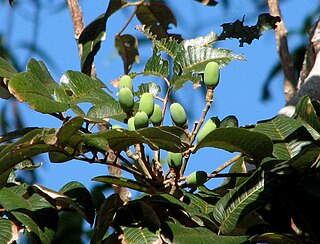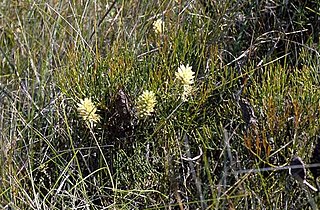
Elaeocarpus is a genus of nearly five hundred species of flowering plants in the family Elaeocarpaceae native to the Western Indian Ocean, Tropical and Subtropical Asia and the Pacific. Plants in the genus Elaeocarpus are trees or shrubs with simple leaves, flowers with four or five usually petals and usually blue fruit.

Flindersia is a genus of 17 species of small to large trees in the family Rutaceae. They have simple or pinnate leaves, flowers arranged in panicles at or near the ends of branchlets and fruit that is a woody capsule containing winged seeds. They grow naturally in Australia, the Moluccas, New Guinea and New Caledonia.

Cenchrus is a widespread genus of plants in the grass family. Its species are native to many countries in Asia, Africa, Australia, the Americas, and various oceanic islands.

Karana Downs is a residential locality in the City of Brisbane, Queensland, Australia. In the 2016 census Karana Downs had a population of 3,862 people.

Alloxylon flammeum, commonly known as the Queensland tree waratah or red silky oak, is a medium-sized tree of the family Proteaceae found in the Queensland tropical rain forests of northeastern Australia. It has shiny green elliptical leaves up to 18 cm (7.2 in) long, and prominent orange-red inflorescences that appear from August to October, followed by rectangular woody seed pods that ripen in February and March. Juvenile plants have large deeply lobed pinnate leaves. Previously known as Oreocallis wickhamii, the initial specimen turned out to be a different species to the one cultivated and hence a new scientific name was required. Described formally by Peter Weston and Mike Crisp in 1991, A. flammeum was designated the type species of the genus Alloxylon. This genus contains the four species previously classified in Oreocallis that are found in Australasia.

Canarium australianum is a species of trees, native to Australia and Papua New Guinea, of the plant family Burseraceae. Common names include mango bark, scrub turpentine, carrot wood, parsnip wood, Melville Island white beech and brown cudgerie.

Elaeocarpus angustifolius is species of flowering plant in the family Elaeocarpaceae and occurs from India to New Calendeonia and northern Australia. It is a large tree, often with buttress roots, and has leaves with wavy serrations, creamy white flowers and more or less spherical bright blue or purple fruit. Authorities differ regarding the distribution of this species.
Stenocarpus cryptocarpus, known as the giant leaf stenocarpus, is a species of trees, of the plant family Proteaceae. It is endemic to some rainforest parts of the wet tropics region of north eastern Queensland, Australia. Notably, juvenile leaves of young trees may reach 115 cm (4 ft) in length.

Petrophile shirleyae is a species of flowering plant in the family Proteaceae and is endemic to Queensland. It is a shrub with pinnate, needle-shaped, sharply-pointed leaves, and narrow oval heads of silky-hairy white to pale cream-coloured flowers.

Hernandia is a genus of flowering plants in the family Hernandiaceae. It was named after the Spanish botanist Francisco Hernández de Toledo.

Hernandia nymphaeifolia is a species of plant in the Hernandiaceae family. Its common name is lantern tree.

Lasjia is a genus of five species of trees of the family Proteaceae. Three species grow naturally in northeastern Queensland, Australia and two species in Sulawesi, Indonesia. Descriptively they are the tropical or northern macadamia trees group. Lasjia species characteristically branched compound inflorescences differentiate them from the Macadamia species, of Australia, which have characteristically unbranched compound inflorescences and only grow naturally about 1,000 km (620 mi) further to the south, in southern and central eastern Queensland and in northeastern New South Wales.

Eimeo is a coastal town and suburb in the Mackay Region, Queensland, Australia. In the 2016 census the suburb of Eimeo had a population of 3,230 people.
Canarium australasicum, commonly named mango bark, brown cudgerie or parsnip wood, is a species of rainforest trees, of the plant family Burseraceae. They are endemic to Australia, in eastern Queensland and far northeastern New South Wales.
Helicia lamingtoniana, also named Lamington's silky oak, is a species of rainforest trees, of northeastern Queensland, Australia, from the flowering plant family Proteaceae.
Helicia nortoniana, also named Norton's silky oak, is a species of rainforest trees, of northeastern Queensland, Australia, from the flowering plant family Proteaceae.

Dicliptera tinctoria is the accepted name of a species in the family Acanthaceae. It may be called magenta plant, or lá cẩm in Vietnamese and native to southeastern Asia from Assam south to Sri Lanka and east to mainland Southeast Asia, Java, southern China, and Taiwan.

Hakea persiehana is a shrub or small tree in the genus Hakea, which comprises approximately 150 species restricted to Australia. Most Hakea seed are usually dispersed by an environmental trigger rather than when seed matures, quite often by fire, whilst other species may require sporadic flooding rains to establish. Hakea is within the family Proteaceae
Elaeocarpus stellaris is a species of flowering plant in the family Elaeocarpaceae and is endemic to north-eastern Queensland. It is a tree, sometimes with buttress roots at the base of the trunk, elliptic to egg-shaped leaves, small groups of flowers with greenish-yellow sepals and creamy-white petals, the fruit conatining a five-flanged stone.













